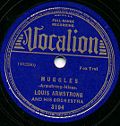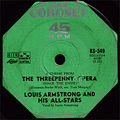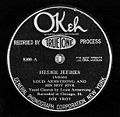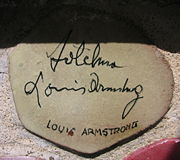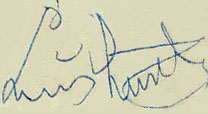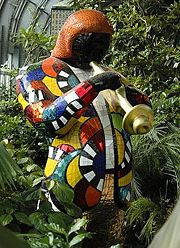Louis Armstrong
2008/9 Schools Wikipedia Selection. Related subjects: Performers and composers
| Louis Armstrong | |
|---|---|
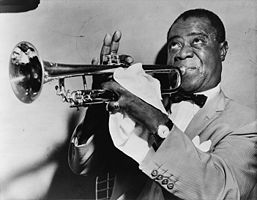 Louis Armstrong's stage personality matched his flashy trumpet. Armstrong is also known for his raspy singing voice.
|
|
| Background information | |
| Birth name | Louis Armstrong |
| Also known as | Satchmo, Pops, Sachimo |
| Born | August 4, 1901 New Orleans, Louisiana, U.S. |
| Died | July 6, 1971 (aged 69) Corona, Queens, New York City, NY, U.S. |
| Genre(s) | Jazz, Dixieland, Swing, Traditional pop |
| Occupation(s) | Trumpeter, Vocalist, American cultural icon |
| Instrument(s) | Trumpet, Cornet |
| Years active | c.1919–1971 |
| Associated acts | Joe "King" Oliver |
Louis Armstrong ( 4 August 1901 – July 6, 1971), nicknamed Satchmo or Sachimo and Pops, was an American jazz trumpeter and singer.
Coming to prominence in the 20s as an innovative cornet and trumpet virtuoso, Armstrong was a foundational influence on jazz, shifting the music's focus from collective improvisation to solo performers. With his distinctive gravelly voice, Armstrong was an influential singer, demonstrating great dexterity as an improviser, bending the lyrics and melody of a song for expressive purposes. He was also greatly skilled at scat singing, or wordless vocalizing.
Renowned for his charismatic stage presence, Armstrong's influence extended well beyond jazz, and by the end of his career in the '60s, he was widely regarded as a profound influence on popular music in general: critic Steve Leggett describes Armstrong as "perhaps the most important American musician of the 20th century."
Biography
Early life
Armstrong often stated in public interviews that he was born on July 4, 1900 (Independence Day in the USA), a date that has been noted in many biographies. Although he died in 1971, it wasn't until the mid-1980s that his true birth date of August 4, 1901 was discovered through the examination of baptismal records. He was recorded as an out of wedlock black child.
Armstrong was born into a very poor family in New Orleans, Louisiana, the grandson of slaves. He spent his youth in poverty in a rough neighbourhood of Uptown New Orleans, known as “Back of Town”, as his father, William Armstrong (1881–1922), abandoned the family when Louis was an infant, and took up with another woman. His mother, Mary Albert Armstrong (1886–1942), then left Louis and his younger sister Beatrice Armstrong Collins (1903–1987) in the care of his grandmother, Josephine Armstrong and at times, his Uncle Isaac. At five, he moved back to live with his mother and her relatives, and saw his father only in parades. He attended the Fisk School for Boys where he likely had his first exposure to Creole music. He brought in a little money as a paperboy and also by finding discarded food and selling it to restaurants but it wasn’t enough to keep his mother from prostitution. He hung out in dance halls, particularly the “Funky Butt,” which was the closest to his home, where he observed everything from licentious dancing to the quadrille. He hauled coal to Storyville, the famed red-light district, and listened to the bands playing in the brothels and dance halls, especially Pete Lala’s where Joe "King" Oliver performed and other famous musicians would drop in to jam.
Armstrong grew up at the bottom of the social ladder, in a highly segregated city, but one which lived in a constant fervor of music, which was generally called “ragtime”, and not yet “jazz”. Despite the hard early days, Armstrong seldom looked back at his youth as the worst of times but instead drew inspiration from it, “Every time I close my eyes blowing that trumpet of mine—I look right in the heart of good old New Orleans...It has given me something to live for.”
After dropping out of the Fisk School at eleven, Armstrong joined a quartet of boys in similar straits as he, and they sang in the streets for money. He also started to get into trouble. Cornet player Bunk Johnson said he taught Armstrong (then 11) to play by ear at Dago Tony's Tonk in New Orleans, although in his later years Armstrong gave the credit to Oliver. His first cornet was bought with money loaned to him by the Karnofskys, a Russian-Jewish immigrant family who had a junk hauling business and gave him odd jobs. To express gratitude towards the Karnofskys, who took him in as almost a family member, and fed and nurtured him, Armstrong wore a Star of David pendant for the rest of his life.
Armstrong seriously developed his cornet playing in the band of the New Orleans Home for Colored Waifs, where he had been sent multiple times for general delinquency, most notably for a long term after firing his stepfather's pistol into the air at a New Year's Eve celebration, as police records confirm. Professor Peter Davis (who frequently appeared at the Home at the request of its administrator, Captain Joseph Jones) instilled discipline in and provided musical training to the otherwise self-taught Armstrong. Eventually, Davis made Armstrong the band leader. The Home band played around New Orleans and the thirteen year old began to draw attention to his cornet playing, starting him on a musical career.At fourteen he was released from the Home, and living again with his father and new stepmother, and then back to his mother and also back to the streets and its temptations. Armstrong got his first dance hall job at Henry Ponce’s where Black Benny became his protector and guide. He hauled coal by day and played his cornet at night.
He also played in the city's frequent brass band parades and listened to older musicians every chance he got, learning from Bunk Johnson, Buddy Petit, Kid Ory, and above all, Joe "King" Oliver, who acted as a mentor and father figure to the young musician. Later, he played in the brass bands and riverboats of New Orleans, and first started traveling with the well-regarded band of Fate Marable which toured on a steamboat up and down the Mississippi River. He described his time with Marable as "going to the University," since it gave him a much wider experience working with written arrangements.
In 1919, Joe Oliver decided to go north and he resigned his position in Kid Ory's band, then regarded as the best hot jazz group in New Orleans. Armstrong replaced his mentor and played second cornet. Soon he was promoted to first cornet and he also became second trumpet for the Tuxedo Brass Band, a society band.
Early career
On March 19, 1918, Louis married Daisy Parker from Gretna, Louisiana. They adopted a 3-year-old boy, Clarence Armstrong, whose mother, Louis's cousin Flora, died soon after giving birth. Clarence Armstrong was mentally disabled (result of a head injury at an early age) and Louis would spend the rest of his life taking care of him. Louis's marriage to Parker failed quickly and they separated. She died shortly after the divorce.
Through his riverboat experiences, Armstrong’s musicianship began to mature. At twenty, he could now read music and he started to be featured in extended trumpet solos, one of the first jazzmen to do this, injecting his own personality and style into his solo turns. He had learned how to create a unique sound, and also started using singing and patter in his performances. In 1922, Armstrong joined the exodus to Chicago, where he had been invited by his mentor, Joe "King" Oliver, to join his Creole Jazz Band, and where he could make a sufficient income so that he no longer need to supplement his music with day labor jobs. It was a boom time in Chicago and though race relations were poor, the “Windy City” was teeming with jobs for blacks, who were making good wages in factories and had plenty to spend on entertainment.
Oliver's band was the best and most influential hot jazz band in Chicago in the early 1920s, at a time when Chicago was the centre of the jazz universe. Armstrong lived like a king in Chicago, in his own apartment with his own private bath (his first). Excited as he was to be in Chicago, he began his career-long pastime of writing nostalgic letters to friends in New Orleans. As Armstrong’s reputation grew, he was challenged to “cutting contests” by hornmen trying to displace the new phenom, who could blow two hundred high C’s in a row. Armstrong made his first recordings on the Gennett and Okeh labels (jazz records were starting to boom across the country), including taking some solos and breaks, while playing second cornet in Oliver's band in 1923. At this time, he met Hoagy Carmichael (with whom he would collaborate later) who was introduced by pal Bix Beiderbecke, who now had his own Chicago band.
Armstrong enjoyed working with Oliver, but Louis' second wife, pianist Lil Hardin Armstrong, urged him to seek more prominent billing and develop his newer style away from the influence of Oliver. She had her husband play classical music in church concerts to broaden his skill and improve his solo play, and she prodded him into wearing more stylish attire to make him look sharp and to better offset his growing girth. Lil’s influence eventually undermined Armstrong’s relationship with his mentor, especially concerning his salary and additional moneys that Oliver held back from Armstrong and other band members. Armstrong and Oliver parted amicably in 1924 and Armstrong received an invitation to go to New York City to play with the Fletcher Henderson Orchestra, the top African–American band of the day. Armstrong switched to the trumpet to blend in better with the other musicians in his section. His influence upon Henderson's tenor sax soloist, Coleman Hawkins, can be judged by listening to the records made by the band during this period.
Armstrong quickly adapted to the more tightly controlled style of Henderson, playing trumpet and even experimenting with the trombone, and the other members quickly took up Armstrong’s emotional, expressive pulse. Soon his act included singing and telling tales of New Orleans characters, especially preachers.The Henderson Orchestra was playing in the best venues for white-only patrons, including the famed Roseland Ballroom, featuring the classy arrangements of Don Redman. Duke Ellington’s orchestra would go to Roseland to catch Armstrong’s performances and young hornmen around town tried in vain to outplay him, splitting their lips in their attempts.
During this time, Armstrong also made many recordings on the side, arranged by an old friend from New Orleans, pianist Clarence Williams; these included small jazz band sides with the Williams Blue Five (some of the best pairing Armstrong with one of Armstrong's few rivals in fiery technique and ideas, Sidney Bechet) and a series of accompaniments with Blues singers, including Bessie Smith, Ma Rainey, and Alberta Hunter.
Armstrong returned to Chicago in 1925 due mostly to the urging of his wife, who wanted to pump up Armstrong’s career and income. He was content in New York but later would concede that she was right and that the Henderson Orchestra was limiting his artistic growth. In publicity, much to his chagrin, she billed him as “the World’s Greatest Trumpet Player”. At first he was actually a member of the Lil Hardin Armstrong Band and working for his wife.He began recording under his own name for Okeh with his famous Hot Five and Hot Seven groups, producing hits such as " Potato Head Blues", " Muggles" (a reference to marijuana, for which Armstrong had a lifelong fondness), and " West End Blues", the music of which set the standard and the agenda for jazz for many years to come.
The group included Kid Ory (trombone), Johnny Dodds (clarinet), Johnny St. Cyr (banjo), wife Lil on piano, and usually no drummer. Armstrong’s bandleading style was easygoing, as St. Cyr noted, "One felt so relaxed working with him and he was very broad-minded...always did his best to feature each individual". His recordings with pianist Earl "Fatha" Hines (most famously their 1928 Weatherbird duet) and Armstrong's trumpet introduction to "West End Blues" remain some of the most famous and influential improvisations in jazz history. Armstrong was now free to develop his personal style as he wished, which included a heavy dose of effervescent jive, such as "whip that thing, Miss Lil" and "Mr. Johnny Dodds, Aw, do that clarinet, boy!"
Armstrong also played with Erskine Tate’s Little Symphony, actually a quintet, which played mostly at the Vendome Theatre. They furnished music for silent movies and live shows, including jazz versions of classical music, such as “Madame Butterfly”, which gave Armstrong experience with longer forms of music and with hosting before a large audience. He began to scat sing (improvised vocal jazz using non-sensical words) and was among the first to record it, on Heebie Jeebies in 1926. So popular was the recording the group became the most famous jazz band in America even though they as yet had not performed live to any great degree. Young musicians across the country, black and white, were turned on by Armstrong’s new type of jazz.
After separating from Lil, Armstrong started to play at the Sunset Café for Al Capone associate Joe Glaser in the Carroll Dickerson Orchestra, with Earl Hines on piano, which was soon renamed Louis Armstrong and his Stompers, though Hines was the music director and Glaser managed the orchestra. Hines and Armstrong became fast friends as well as successful collaborators.
Armstrong returned to New York, in 1929, where he played in the pit orchestra of the successful musical Hot Chocolate, an all-black revue written by Andy Razaf and pianist/composer Fats Waller. He also made a cameo appearance as a vocalist, regularly stealing the show with his rendition of " Ain't Misbehavin'", his version of the song becoming his biggest selling record to date.
He started to work at Connie's Inn in Harlem, the second nightspot in fame to the Cotton Club, and a front for gangster Dutch Schultz. Armstrong also had considerable success with vocal recordings, including versions of famous songs composed by his old friend Hoagy Carmichael. His 1930s recordings took full advantage of the new RCA ribbon microphone, introduced in 1931, which imparted a characteristic warmth to vocals and immediately became an intrinsic part of the ' crooning' sound of artists like Bing Crosby. Armstrong's famous interpretation of Hoagy Carmichael's " Stardust" became one of the most successful versions of this song ever recorded, showcasing Armstrong's unique vocal sound and style, and his innovative approach to singing songs that had already become standards.
Armstrong's radical re-working of Sidney Arodin and Carmichael's " Lazy River" (recorded in 1931) encapsulated many features of his groundbreaking approach to melody and phrasing. The song begins with a brief trumpet solo, then the main melody is stated by sobbing horns, which are memorably punctuated by Armstrong's growling interjections at the end of each bar: "Yeah! ..."Uh-huh" ..."Sure" ... "Way down, way down". In the first verse, he ignores the notated melody entirely, and sings as if playing a trumpet solo, pitching most of the first line on a single note and using strongly syncopated phrasing. In the second stanza he breaks into an almost fully improvised melody, which then evolves into a classic passage of Armstrong " scat singing."
As with his trumpet playing, Armstrong's vocal innovations served as a foundation stone for the art of jazz vocal interpretation. The uniquely gritty coloration of his voice became a musical archetype that was much imitated and endlessly impersonated. His scat singing style was enriched by his matchless experience as a trumpet soloist. His resonant, velvety lower-register tone and bubbling cadences on sides such as "Lazy River" exerted a huge influence on younger white singers such as Bing Crosby.
The Depression of the early Thirties was especially hard on the Jazz scene. The Cotton Club closed in 1936 after a long downward spiral and many musicians stopped playing altogether as club dates evaporated. Bix Beiderbecke died and Fletcher Henderson’s band broke up. King Olivier made a few records but otherwise struggled. Sidney Bechet became a tailor and Kid Ory returned to New Orleans and raised chickens. Armstrong moved to Los Angeles in 1930 seeking new opportunities. He played at the New Cotton Club in LA with Lionel Hampton on drums, and the band drew the Hollywood crowd which could still afford a lavish night life, and radio broadcasts from the club connected with younger audiences at home. Bing Crosby and many other celebrities were regulars at the club. In 1931, Armstrong appeared in his first movie, Ex-Flame. Armstrong was convicted of marijuana possession but received a suspended sentence. He returned to Chicago in late 1931, and played in bands more in the Guy Lombardo vein and he recorded more standards. When the mob insisted that he get out of town, Armstrong visited New Orleans and got a hero’s welcome, and saw old friends. He sponsored a local baseball team known as “Armstrong’s Secret Nine” and got a cigar named after himself. But soon he was on the road again and after a tour across the country shadowed by the mob, Armstrong decided to go to Europe to escape.
After returning to the States, he undertook several exhausting tours. His agent Johnny Collins’ erratic behaviour and his own spending ways left Armstrong short of cash. Breach of contract violations plagued him. Finally, he hired Joe Glaser as his new manager, a tough mob-connected wheeler-dealer, who began to straighten out his legal mess, his mob troubles, and his debts. Armstrong also began to experience problems with his fingers and lips, which were aggravated by his unorthodox playing style. As a result he branched out, developing his vocal style and making his first theatrical appearances. He appeared in movies again. In 1937, Armstrong substituted for Rudy Vallee on the CBS radio network and became the first black to host a sponsored, national broadcast. He finally divorced Lil in 1938 and married longtime girlfriend Alpha.
After spending many years on the road, he settled permanently in Queens, New York in 1943 in contentment with his fourth wife, Lucille. Although subject to the vicissitudes of Tin Pan Alley and the gangster-ridden music business, as well as anti-black prejudice, he continued to develop his playing. He recorded Hoagy Carmichael's Rockin' Chair for Okeh Records.
During the subsequent thirty years, Armstrong played more than three hundred gigs a year. Bookings for big bands tapered off during the 1940s due to changes in public tastes: ballrooms closed, and there was competition from television and from other types of music becoming more popular than big band music. It became impossible under such circumstances to support and finance a 16-piece touring band.
The All Stars
Following a highly successful small-group jazz concert at New York Town Hall on May 17, 1947, featuring Armstrong with trombonist/singer Jack Teagarden, Armstrong's manager Joe Glaser dissolved the Armstrong big band on August 13, 1947 and established a six-piece small group featuring Armstrong with (initially) Teagarden, Earl Hines and other top swing and dixieland musicians, most of them ex-big band leaders. The new group was announced at the opening of Billy Berg's Supper Club.
This group was called the All Stars, and included at various times Earl "Fatha" Hines, Barney Bigard, Edmond Hall, Jack Teagarden, Trummy Young, Arvell Shaw, Billy Kyle, Marty Napoleon, Big Sid Catlett, Cozy Cole, Barrett Deems and the Filipino-American percussionist, Danny Barcelona. During this period, Armstrong made many recordings and appeared in over thirty films. He appeared on the cover of Time Magazine on February 21, 1949.
In 1964, he recorded his biggest-selling record, " Hello, Dolly!". The song went to #1 on the pop chart, making Armstrong (age 63) the oldest person to ever accomplish that feat. In the process, Armstrong dislodged The Beatles from the #1 position they had occupied for 14 consecutive weeks with three different songs.
Armstrong kept up his busy tour schedule until a few years before his death in 1971. In his later years he would sometimes play some of his numerous gigs by rote, but other times would enliven the most mundane gig with his vigorous playing, often to the astonishment of his band. He also toured Africa, Europe, and Asia under sponsorship of the US State Department with great success, earning the nickname "Ambassador Satch." While failing health restricted his schedule in his last years, within those limitations he continued playing until the day he died.
Personality
The nickname Satchmo or Satch is short for Satchelmouth (describing his embouchure). In 1932, then Melody Maker magazine editor Percy Brooks greeted Armstrong in London with "Hello, Satchmo!" shortening Satchelmouth (some say unintentionally), and it stuck.
Early on he was also known as Dippermouth. This is a reference to the propensity he had for refreshing himself with the dipper (ladle) from a bucket of sugar water which was always present on stage with Joe Oliver's band in Chicago in the early nineteen-twenties.
The damage to his embouchure from his high pressure approach to playing is acutely visible in many pictures of Louis from the mid-twenties. It also led to his emphasizing his singing career because at certain periods, he was unable to play. However, after having set his trumpet aside for a while, he amended his playing style and continued his trumpet career. Friends and fellow musicians usually called him Pops, which is also how Armstrong usually addressed his friends and fellow musicians (except for Pops Foster, whom Armstrong always called "George").
He was also criticized for accepting the title of "King of The Zulus" -- in the New Orleans African-American community, an honored role as head of leading black Carnival Krewe, but bewildering or offensive to outsiders with their traditional costume of grass-skirts and blackface makeup satirizing southern white attitudes -- for Mardi Gras 1949.
Whatever the case, where some saw a gregarious and outgoing personality, others saw someone trying too hard to appeal to white audiences and essentially becoming a minstrel caricature. Some musicians criticized Armstrong for playing in front of segregated audiences, and for not taking a strong enough stand in the civil rights movement suggesting that he was an Uncle Tom. Billie Holiday countered, however, "Of course Pops toms, but he toms from the heart."
Armstrong, in fact, was a major financial supporter of Dr. Martin Luther King Jr. and other civil rights activists, but mostly preferred to work quietly behind the scenes, not mixing his politics with his work as an entertainer. The few exceptions made it more effective when he did speak out. Armstrong's criticism of President Eisenhower, calling him "two-faced" and "gutless" because of his inaction during the conflict over school desegregation in Little Rock, Arkansas in 1957 made national news. As a protest, Armstrong canceled a planned tour of the Soviet Union on behalf of the State Department saying "The way they're treating my people in the South, the government can go to hell" and that he could not represent his government abroad when it was in conflict with its own people. The FBI kept a file on Armstrong, for his outspokenness about integration.
He was an extremely generous man, who was said to have given away as much money as he kept for himself. Armstrong was also greatly concerned with his health and bodily functions. He made frequent use of laxatives as a means of controlling his weight, a practice he advocated both to personal acquaintances and in the diet plans he published under the title Lose Weight the Satchmo Way. Armstrong's laxative of preference in his younger days was Pluto Water, but he then became an enthusiastic convert when he discovered the herbal remedy Swiss Kriss. He would extol its virtues to anyone who would listen and pass out packets to everyone he encountered, including members of the British Royal Family. (Armstrong also appeared in humorous, albeit risqué, advertisements for Swiss Kriss; the ads bore a picture of him sitting on a toilet — as viewed through a keyhole — with the slogan "Satch says, 'Leave it all behind ya!'")
The concern with his health and weight was balanced by his love of food, reflected in such songs as "Big Butter & Egg Man", "Cheesecake", "Cornet Chop Suey", and, especially, "Struttin’ with Some Barbecue". He kept a strong connection throughout his life to the cooking of New Orleans, always signing his letters, "Red beans and ricely yours,".
Although Armstrong is not known to have fathered any children, he loved children and would go out of his way to entertain the neighbourhood kids in Corona, and to encourage young musicians.
Armstrong’s gregariousness extended to writing. On the road, he wrote constantly. Many of the favorite themes of his life he shared with correspondents around the world. He avidly typed or wrote on whatever stationery was at hand, instant takes on music, sex, food, childhood memories, his heavy “medicinal” marijuana use, and even his bowel movements, which were gleefully described. He had a fondness for lewd jokes and dirty limericks as well.
Armstrong was an avid audiophile. He had a large collection of recordings, including reel-to-reel tapes which he took on the road with him in a trunk during his later career. He enjoyed listening to his own recordings, and comparing his performances musically. In the den of his home, he had the latest audio equipment and would sometimes rehearse and record along with his older recordings or the radio.
Death
Armstrong died of a heart attack on July 6, 1971, at age 69, 11 months after playing a famous show at the Waldorf-Astoria's Empire Room. Shortly before his death he stated, "I think I had a beautiful life. I didn't wish for anything that I couldn't get and I got pretty near everything I wanted because I worked for it." He was residing in Corona, Queens, New York City, at the time of his passing. He was interred in Flushing Cemetery, Flushing, in Queens, New York City.
His honorary pallbearers included Governor Rockefeller, Mayor Lindsay, Bing Crosby, Ella Fitzgerald, Guy Lombardo, Duke Ellington, Dizzy Gillespie, Pearl Bailey, Count Basie, Harry James, Frank Sinatra, Ed Sullivan, Earl Wilson, Alan King, Johnny Carson, David Frost, Merv Griffin, Dick Cavett and Bobby Hackett. Peggy Lee, one of Armstrong's favorite vocalists, sang The Lord's Prayer at the services.
Music
Armstrong gained fame as a horn player, then later became better known as a bandleader, vocalist, musical ambassador, and founding figure in much modern American music.
Horn playing and early jazz
In his early years, Armstrong was best known for his virtuosity with the cornet and trumpet. The greatest trumpet playing of his early years can be heard on his Hot Five and Hot Seven records. The improvisations which he made on these records of New Orleans jazz standards and popular songs of the day continue to stack up brilliantly alongside those of any other later jazz performer. The older generation of New Orleans jazz musicians often referred to their improvisations as "variating the melody"; Armstrong's improvisations were daring and sophisticated for the time while often subtle and melodic.
He often essentially re-composed pop-tunes he played, making them more interesting. Armstrong's playing is filled with joyous, inspired original melodies, creative leaps, and subtle relaxed or driving rhythms. The genius of these creative passages is matched by Armstrong's playing technique, honed by constant practice, which extended the range, tone and capabilities of the trumpet. In these records, Armstrong almost single-handedly created the role of the jazz soloist, taking what was essentially a collective folk music and turning it into an art form with tremendous possibilities for individual expression.
Armstrong's work in the 1920s shows him playing at the outer limits of his abilities. The Hot Five records, especially, often have minor flubs and missed notes, which do little to detract from listening enjoyment since the energy of the spontaneous performance comes through. By the mid 1930s, Armstrong achieved a smooth assurance, knowing exactly what he could do and carrying out his ideas with perfectionism.
Vocal popularity
As his music progressed and popularity grew, his singing also became important. Armstrong was not the first to record scat singing, but he was masterful at it and helped popularize it. He had a hit with his playing and scat singing on " Heebie Jeebies" when, according to some legends, the sheet music fell on the floor and he simply started singing nonsense syllables. Armstrong stated in his memoirs that this actually occurred. He also sang out "I done forgot the words" in the middle of recording "I'm A Ding Dong Daddy From Dumas".
Such records were hits and scat singing became a major part of his performances. Long before this, however, Armstrong was playing around with his vocals, shortening and lengthening phrases, interjecting improvisations, using his voice as creatively as his trumpet.
Colleagues and followers
During his long career he played and sang with the most important instrumentalists and vocalists; among the many, singing brakeman Jimmie Rodgers, Bing Crosby, Duke Ellington, Fletcher Henderson, Bessie Smith, and notably with Ella Fitzgerald.
His influence upon Bing Crosby is particularly important with regard to the subsequent development of popular music: Crosby admired and copied Armstrong, as is evident on many of his early recordings, notably "Just One More Chance" (1931). The New Grove Dictionary Of Jazz describes Crosby's debt to Armstrong in perfect detail, although it does not acknowledge Armstrong by name: "Crosby...was important in introducing into the mainstream of popular singing an Afro-American concept of song as a lyrical extension of speech...His techniques - easing the weight of the breath on the vocal cords, passing into a head voice at a low register, using forward production to aid distinct enunciation, singing on consonants (a practice of black singers), and making discreet use of appoggiaturas, mordents, and slurs to emphasize the text - were emulated by nearly all later popular singers".
Armstrong recorded three albums with Ella Fitzgerald: Ella and Louis, Ella and Louis Again, and Porgy and Bess for Verve Records, with the sessions featuring the backing musicianship of the Oscar Peterson Trio and drummer Buddy Rich. His recordings Satch Plays Fats, all Fats Waller tunes, and Louis Armstrong Plays W.C. Handy in the 1950s were perhaps among the last of his great creative recordings, but even oddities like Disney Songs the Satchmo Way are seen to have their musical moments. And, his participation in Dave Brubeck's high-concept jazz musical The Real Ambassadors was critically acclaimed. For the most part, however, his later output was criticized as being overly simplistic or repetitive.
Hits and later career
Armstrong had many hit records including " Stardust", " What a Wonderful World", " When The Saints Go Marching In", " Dream a Little Dream of Me", " Ain't Misbehavin'", and "Stompin' at the Savoy". " We Have All the Time in the World" featured on the soundtrack of the James Bond film On Her Majesty's Secret Service, and enjoyed renewed popularity in the UK in 1994 when it featured on a Guinness advert. It reached number 3 in the charts on being re-released.
In 1964, Armstrong knocked the Beatles off the top of the Billboard Top 100 chart with " Hello, Dolly", which gave the 63-year-old performer a U.S. record as the oldest artist to have a #1 song. In 1968, Armstrong scored one last popular hit in the United Kingdom with the highly sentimental pop song " What a Wonderful World", which topped the British charts for a month; however, the single did not chart at all in America. The song gained greater currency in the popular consciousness when it was used in the 1987 movie Good Morning, Vietnam, its subsequent rerelease topping many charts around the world. Armstrong even appeared on the 28 October 1970 Johnny Cash Show, where he sang Nat "King" Cole's hit " Rambling Rose" and joined Cash to re-create his performance backing Jimmie Rodgers on " Blue Yodel # 9.""
Stylistic range
Armstrong enjoyed many types of music, from blues to the arrangements of Guy Lombardo, to Latin American folksongs, to classical symphonies and opera. Armstrong incorporated influences from all these sources into his performances, sometimes to the bewilderment of fans who wanted Armstrong to stay in convenient narrow categories. Armstrong was inducted into Rock and Roll Hall of Fame as an early influence. Some of his solos from the 1950s, such as the hard rocking version of " St. Louis Blues" from the WC Handy album, show that the influence went in both directions.
Literature, Radio, films and TV
Armstrong appeared in more than a dozen Hollywood films, usually playing a band leader or musician. His most familiar role was as the bandleader cum narrator in the 1956 musical, High Society, in which he sang the title song and performed a duet with Bing Crosby on " Now You Has Jazz". In 1947, he played himself in the movie New Orleans opposite Billie Holiday, which chronicled the demise of the Storyville district and the ensuing exodus of musicians from New Orleans to Chicago . He was the first African American to host a nationally broadcast radio show in the 1930s.
He was heard on such radio programs as The Story of Swing (1937) and This Is Jazz (1947), and he also made countless television appearances, especially in the 1950s and 1960s, including appearances on The Tonight Show Starring Johnny Carson.
Louis Armstrong has a record star on the Hollywood Walk of Fame on 7601 Hollywood Boulevard.
Many of Armstrong's recordings remain popular. Almost four decades since his passing, a larger number of his recordings from all periods of his career are more widely available than at any time during his lifetime. His songs are broadcast and listened to every day throughout the world, and are honored in various movies, TV series, commercials, and even anime and computer games. "A Kiss to Build a Dream On" was included in the computer game Fallout 2, accompanying the intro cinematic (and the year after in the movie Sleepless in Seattle). His 1923 recordings, with Joe Oliver and his Creole Jazz Band, continue to be listened to as documents of ensemble style New Orleans jazz, but more particularly as ripper jazz records in their own right. All too often, however, Armstrong recorded with stiff, standard orchestras leaving only his sublime trumpet playing as of interest. "Melancholy Blues," performed by Armstrong and his Hot Seven was included on the Voyager Golden Record sent into outer space to represent one of the greatest achievements of humanity. Most familiar to modern listeners is his ubiquitous rendition of " What a Wonderful World." In 2008, Armstrong's recording of Edith Piaf's famous " La Vie En Rose" was used in a scene of the popular Disney/Pixar film Wall-E.
Argentine writer Julio Cortázar, a self-described Armstrong admirer, asserted that a 1952 Louis Armstrong concert at the Théâtre des Champs-Élysées in Paris played a significant role in inspiring him to create the fictional creatures called Cronopios that are the subject of a number of Cortázar's short stories. Cortázar once called Louis Armstrong himself "Grandísimo Cronopio" (Most Enormous Cronopio).
Armstrong also appears as a minor character in Harry Turtledove's Timeline-191 series. When he and his band escape from a Nazi-like Confederacy, they enhance the insipid mainstream music of the North.
There is a pivotal scene in 1980's Stardust Memories in which Woody Allen is overwhelmed by a recording of Armstrong's Stardust and experiences a nostalgic epiphany . The combination of the music and the perfect moment is the catalyst for much of the film's action, prompting the protagonist to fall in love with an ill-advised woman .
Louis Armstrong is also referred to in The Trumpet of the Swan along with Ella Fitzgerald and Billie Holiday. Three siblings in the film are named Louis, Billie, and Ella. The main character, Louis, plays a trumpet, an obvious nod to Armstrong.
In the original EB White book, he is referred to by name by a child who hears Louis playing and comments "He sounds just like Louis Armstrong, the famous trumpet player".
Awards and honours
Grammy Awards
Armstrong was posthumously awarded the Grammy Lifetime Achievement Award in 1972, by the Academy of Recording Arts and Sciences. This Special Merit Award is presented by vote of the Recording Academy's National Trustees to performers who, during their lifetimes, have made creative contributions of outstanding artist significance to the field of recording.
| Grammy Award | |||||
| Year | Category | Title | Genre | Label | Result |
|---|---|---|---|---|---|
| 1964 | Male Vocal Performance | " Hello, Dolly!" | Pop | Kapp | Winner |
Grammy Hall of Fame
Recordings of Armstrong were inducted into the Grammy Hall of Fame, which is a special Grammy award established in 1973 to honour recordings that are at least twenty-five years old, and that have "qualitative or historical significance."
| Grammy Hall of Fame | |||||
| Year Recorded | Title | Genre | Label | Year Inducted | Notes |
|---|---|---|---|---|---|
| 1929 | St. Louis Blues | Jazz (Single) | Okeh | 2008 | |
| 1928 | Weather Bird | Jazz (Single) | Okeh | 2008 | with Earl Hines |
| 1930 | Blue Yodel #9 (Standing on the Corner) |
Country (Single) | Victor | 2007 | Jimmie Rodgers (Featuring Louis Armstrong) |
| 1932 | All of Me | Jazz (Single) | Columbia | 2005 | |
| 1958 | Porgy and Bess | Jazz (Album) | Verve | 2001 | with Ella Fitzgerald |
| 1964 | Hello Dolly! | Pop (Single) | Kapp | 2001 | |
| 1926 | Heebie Jeebies | Jazz (Single) | Okeh | 1999 | |
| 1967 | What a Wonderful World | Pop (Single) | ABC | 1999 | |
| 1955 | Mack the Knife | Jazz (Single) | Columbia | 1997 | |
| 1925 | St. Louis Blues | Jazz (Single) | Columbia | 1993 | Bessie Smith with Louis Armstrong, cornet |
| 1928 | West End Blues | Jazz (Single) | Okeh | 1974 | |
Rock and Roll Hall of Fame
The Rock and Roll Hall of Fame listed a song by Armstrong on the list of 500 songs that shaped Rock and Roll.
| Year Recorded | Title | Label | Group | |
|---|---|---|---|---|
| 1928 | West End Blues | Okeh | Louis Armstrong and his Hot Five | |
Inductions and honours
In 1995, the U.S. Post Office issues a Louis Armstrong 32 cents commemorative postage stamp.
| Year Inducted | Title | Results | Notes |
|---|---|---|---|
| 2007 | Gennett Records Walk of Fame, Richmond, Indiana | ||
| 2007 | Long Island Music Hall of Fame | ||
| 2004 | Nesuhi Ertegün Jazz Hall of Fame at Jazz at Lincoln Centre |
||
| 1990 | Rock and Roll Hall of Fame | Early influence | |
| 1978 | Big Band and Jazz Hall of Fame | ||
| 1958 | Down Beat Jazz Hall of Fame | ||
| Hollywood Walk of Fame | Star | at 7601 Hollywood Blvd. | |
Legacy
On December 31, 1999, US President Bill Clinton announced that Armstrong's trumpet was among several items of national memorabilia that were to be interred in a Millennial time capsule to be opened 100 years later.
Today, the house where Louis Armstrong lived at the time of his death (and which was declared a National Historic Landmark in 1977) is a museum. The Louis Armstrong House & Archives, at 34-56 107th Street (between 34th and 35th Avenues) in Corona, Queens, presents concerts and educational programs, operates as an historic house museum and makes materials in its archives of writings, books, recordings and memorabilia available to the public for research. The museum is operated by the City University of New York's Queens College, following the dictates of Armstrong’s will.
The museum was opened to the public on October 15, 2003. In 2005, it was among 406 New York City arts and social service institutions to receive part of a $20 million grant from the Carnegie Corporation, which was made possible through a donation by New York City mayor Michael Bloomberg.
The influence of Armstrong on the development of jazz is virtually immeasurable. Yet, his irrepressible personality both as a performer, and as a public figure later in his career, was so strong that to some it sometimes overshadowed his contributions as a musician and singer.
As a virtuoso trumpet player, Armstrong had a unique tone and an extraordinary talent for melodic improvisation. Through his playing, the trumpet emerged as a solo instrument in jazz and is used widely today. He was a masterful accompanist and ensemble player in addition to his extraordinary skills as a soloist. With his innovations, he raised the bar musically for all who came after him.
Some critics contend that Armstrong essentially invented jazz singing. Though widely recognized as a pioneer of scat singing, Ethel Waters precedes his scatting on record in the 1930s according to Gary Giddens and others. Billie Holiday and Frank Sinatra are just two singers who were greatly indebted to him. Holiday said that she always wanted Bessie Smith's 'big' sound and Armstrong's feeling in her singing.
On August 4, 2001, the centennial of Armstrong's birth, New Orleans' airport was renamed Louis Armstrong International Airport in his honour.
In 2002, the Louis Armstrong's Hot Five and Hot Seven recordings (1925-1928) are preserved in the United States National Recording Registry, a registry of recordings selected yearly by the National Recording Preservation Board for preservation in the National Recording Registry of the Library of Congress.
The US Open tennis tournament's former main stadium was named Louis Armstrong Stadium in honour of Armstrong who had lived a few blocks from the site.
Discography
- Louis Armstrong albums
- Louis Armstrong songs
